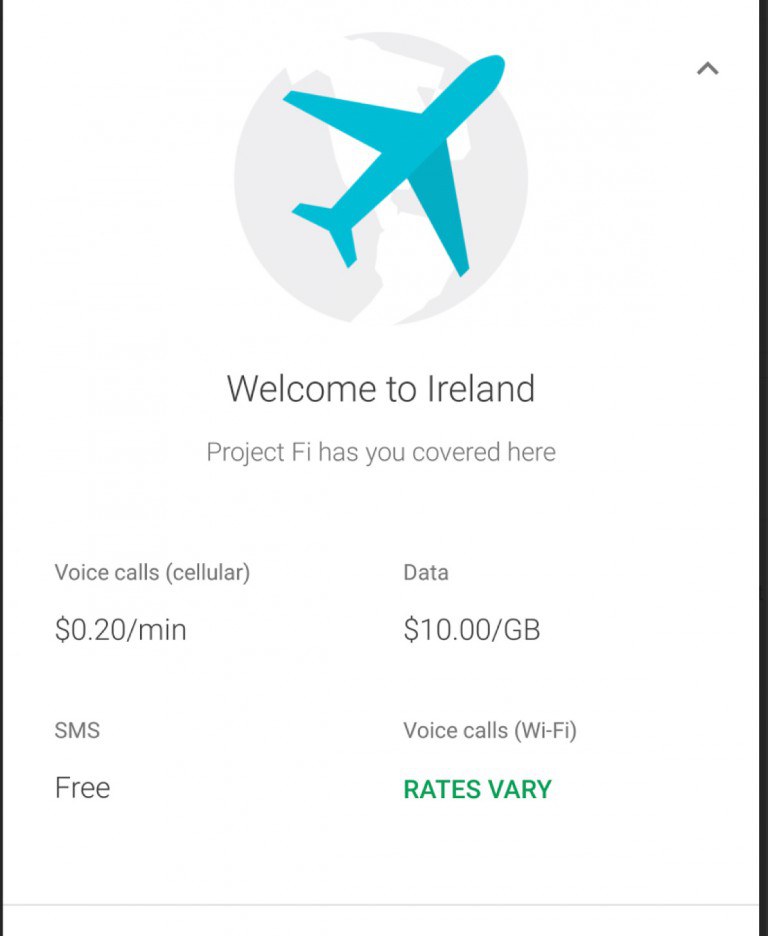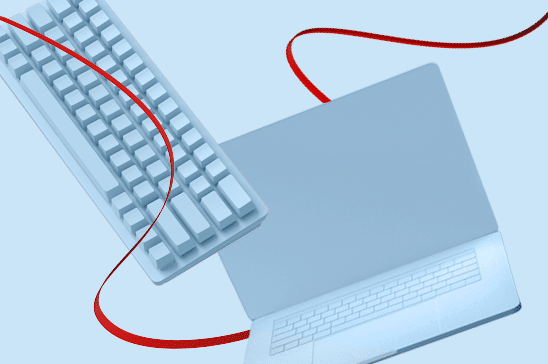How Google’s Project Fi Fixes The International Data Nightmare
Normally, you wouldn’t dare getting off a plane in a foreign country and flipping on your cellular data. International data rates from major U.S. cellular carriers have been prohibitive for years … and you never quite know what your phone is downloading in the background.
But I don’t have a normal cellular carrier.
My cell service comes from Google.
I have been using Project Fi on a Nexus 6P from Google since mid-December. Google operates as an MVNO—mobile virtual network operator—and leases spectrum from the likes of T-Mobile and Sprint to provide one of the most unique and flexible cell services in the world.
When I got off the plane in Dublin on my way to Barcelona to attend Mobile World Congress, Project Fi had a message for me: “Welcome to Ireland. Project Fi has you covered here.”
How Project Fi Works
Project Fi works on a pre-paid basis. For $20 a month Project Fi provides unlimited domestic calls and texts (domestic and international). You then pay $10 for every gigabyte of cellular data you use from there on out. At the beginning of the month you estimate how many GB of data you are going to use and pre-pay that amount. So, if I think I am going to use 3 GB of data, I am going to pay Google $30 for the data. So my baseline cellular bill for the month is going to be $50 before applicable taxes and device payments.

The ingenuity of Project Fi is that you pay for exactly what you use. Really. Instead of paying $10 per GB, I am paying $1 for every 0.1 GB of data. Project Fi calculates how much data you use that month and then rolls over the difference from your pre-payment to the next month. For instance, I paid for 3 GB of data in my January/February billing cycle. But I only used 1.293 GB of data (I was mostly at home on Wi-Fi during the month). So Google credited my account $17.07 for unused data and my monthly bill was only $60.73.
On the flip side, if I used 3.53 GB of data, I would pay an extra $5.30 on my next bill.
Google actively pushes Project Fi users to Wi-Fi when it is available. For public Wi-Fi, Project Fi has an intelligent assistant to connect people and protect them with a built-in VPN. Project Fi also provides the ability to turn a smartphone into a mobile hotspot that can be tethered to other devices. This capability was very handy for me at the 2016 Consumer Electronics Show in Las Vegas when the Wi-Fi at the keynote events was unreliable but I could use my phone for fast and reliable LTE connection for my laptop.
The best part about the flexible $10/GB model from Project Fi? It works just about everywhere. No extra fees for international roaming.
Google promises that Project Fi can provide data in 120 countries around the world. Over the past couple of weeks, I put this claim to the test.
Google announced this week that Project Fi is now open to anybody, no more beta-period invitation required. Project Fi still only works with newer Nexus smartphones, but Google has experimented with selling data-only SIM cards to put into the likes of cars and tablets.
The International Data Nightmare
Google says that 15% of the initial Project Fi users have used the service internationally. I am firmly among that group.
Really, the international capabilities of Project Fi were the reason I signed up and bought a Nexus 6P in the first place.
I am a bit of an odd duck for a national U.S. technology journalist. I live in Boston instead of San Francisco or New York. I have not been to San Francisco in more than a year and have spent more than a month in Europe since November 2014. This year I will spend probably about two or three weeks in San Francisco and probably five or six weeks in Europe at various tech conferences and vacation.
Over the years I’ve had some interesting experiences getting cellular data in Europe. My first trip to London (for Nokia World 2011), I didn’t have any data and wandered the streets of the city aimlessly, ducking into Starbucks to get Wi-Fi on my iPad just to figure out where I was. At Mobile World Congress 2014 in Barcelona I bought a data-only SIM card for an unlocked Nexus 5 for €10 for 1 GB of data and it worked great. The next year in Barcelona I had the same plan and the SIM card kept running out of data (even though I hadn’t hit a GB yet) and I had to keep topping it off at another €10. I probably spent €60 on data on that trip.
In Paris for LeWeb 2014, I bought an Orange SIM card at the airport for the same unlocked Nexus 5 for €45 for a GB of data, 250 texts and 100 minutes of international calling. It worked great and the data reception in Paris worked well enough that I was making Google Hangouts video calls over LTE. In Dublin at Web Summit 2015, I didn’t even bother and just used Wi-Fi the entire time.
The alternative would have been getting an expensive international data plan from my U.S. carrier (AT&T) at the time that I would have used maybe once or twice a year. Or pay international data rates for data, calls and texts (AT&T used to charge $0.25 for every international text) that were so expensive it was comical.
Getting international data in Europe has been an expensive adventure over the years. Hence, I was excited—if a bit skeptical—of Project Fi’s promise to cover me for the same rate without the need for an international SIM card in Europe.
Touring Southern Europe With Project Fi
The notification I got from Project Fi in Dublin was just the first of several such messages I would get over the next couple of weeks. Every time I crossed a border, Project Fi would send me a message.
“Welcome to Spain. Project Fi has you covered here.”
“Welcome to France. Project Fi has you covered here.”
“Welcome to Italy. Project Fi has you covered here.”
From Dublin, I spent about six days in Barcelona for Mobile World Congress. Every day I got near-4G quality coverage on an HSPA network. I displaced to Wi-Fi frequently at the Fira Gran Via conference center.
The interesting thing about Project Fi is that it scans for the best network or Wi-Fi connection across multiple bandwidth spectrums and uses that. In Europe, I did not find a single LTE network outside of the Dublin airport and was on 3G or HSPA networks nearly the entire time.
From Catalonia after MWC, I took an extended vacation through southern Europe. I took the train from Barcelona to Montpellier in France on my way to two days in Marseille. Cellular data on trains can be spotty as you rapidly move from one tower to another. But, with a few exceptions, I was able to get mostly reliable HSPA connections through western Spain and southern France. It was not the fastest cellular data ever, but it worked.
From Marseille I proceeded to Florence by train via Nice and Milan. This is where things got spotty. While the train ride through southwestern France and northeastern Italy is stunning, the area is a bit of a hinterland between moderately sized towns and cities. Cellular coverage would frequently drop. When it came “back” it wouldn’t actually have any connection. Have you ever been connected to your home Wi-Fi with an “excellent” connection, but had no throughput because the modem was down?
That was my data coverage on the train to Florence, especially on the Italian side of the trip. To get data back, I had to turn the Nexus 6P off and back on again.
The coverage in Florence was fine, once again on an HSPA network. It was slow but reliable and better than any public Wi-Fi I found or the Wi-Fi in my AirBnB. The connection dropped occasionally.
From Florence I took the train to Rome, where I spent five days. When I finally stopped moving, the connected-but-no-data problem dissipated and once again I was on a sturdy HSPA network, occasionally dropping to a 3G network. It would drop in my basement apartment AirBnB but come back when I stepped outside.
Free, unlimited texts were essential in staying in touch with friends and family in the U.S. while I was away. I didn’t make many calls, but the $0.20 a minute option was there over a cell connection if I needed it. Project Fi offers Wi-Fi calling options, but I did not end up using it.
I took nearly 1,500 pictures during my two-plus weeks in Europe. To stop from consuming a lot of data, I had to turn the Google Photos automatic backup option to Wi-Fi only. But before I did, Google Photos backed up about 700 pictures from the trip sucking up about 1.7 GB of data. I also had to turn off automatic app updates from Google Play. During the entire trip, I used 3.79 GB of data and I still have two weeks left in the billing cycle.
So, I will be paying a little extra on my Project Fi bill next month. Considering the alternatives, I am willing to pay an extra $15 or $20 for heavy data use in Europe for a few weeks. In sum, Project Fi was everything it promised to be: reliable, cheap data everywhere I went with little hassle and no international SIM cards or roaming charges. Project Fi is truly the international data plan I have been waiting for.







